The generation principle of hot-dip galvanized coating
Hot dip galvanizing is a process of metallurgical chemical reaction. From a microscopic perspective, the process of hot-dip galvanizing involves two dynamic equilibria: thermal equilibrium and zinc iron exchange equilibrium. When steel parts are immersed in molten zinc at around 450 ℃, the steel parts at room temperature absorb the heat of the zinc liquid. When the temperature exceeds 200 ℃, the interaction between zinc and iron gradually becomes apparent, and zinc infiltrates the surface layer of the iron steel parts.

As the temperature of the steel gradually approaches the temperature of the zinc liquid, alloy layers with different zinc iron ratios are formed on the surface layer of the steel, forming a layered structure of the zinc coating. As time goes on, different alloy layers in the coating exhibit different growth rates. From a macro perspective, the above process manifests as steel parts being immersed in zinc liquid, causing boiling of the zinc liquid surface. As the zinc iron chemical reaction gradually equilibrates, the zinc liquid surface gradually calms down.
When the steel piece is raised to the zinc liquid level, and the temperature of the steel piece gradually decreases to below 200 ℃, the zinc iron chemical reaction stops, and a hot-dip galvanized coating is formed, with the thickness determined.
Thickness requirements for hot-dip galvanized coatings
The main factors affecting the thickness of zinc coating include: substrate metal composition, surface roughness of steel, content and distribution of active elements silicon and phosphorus in steel, internal stress of steel, geometric dimensions of steel parts, and hot-dip galvanizing process.
The current international and Chinese hot-dip galvanizing standards are divided into sections based on the thickness of steel. The global and local thickness of the zinc coating should reach the corresponding thickness to determine the corrosion resistance of the zinc coating. The time required to achieve thermal equilibrium and stable zinc iron exchange equilibrium varies for steel parts with different thicknesses, resulting in different coating thicknesses. The average coating thickness in the standard is based on the industrial production experience value of the hot-dip galvanizing principle mentioned above, and the local thickness is the experience value required to consider the uneven distribution of zinc coating thickness and the requirements for coating corrosion resistance.

Therefore, ISO standards, American ASTM standards, Japanese JIS standards, and Chinese standards have slightly different requirements for zinc coating thickness, and the difference is not significant.
The effect and influence of hot-dip galvanized coating thickness
The thickness of hot-dip galvanized coating determines the corrosion resistance of the plated parts. For detailed discussion, please refer to the relevant data provided by the American Hot Dip Galvanization Association in the attachment. Customers can also choose a zinc coating thickness that is higher or lower than the standard.
It is difficult to obtain a thicker coating in industrial production for thin steel plates with a smooth surface layer of 3mm or less. In addition, the zinc coating thickness that is not proportional to the steel thickness can affect the adhesion between the coating and the substrate, as well as the appearance quality of the coating. An excessively thick coating can cause the appearance of the coating to be rough, prone to peeling, and the plated parts cannot withstand collisions during transportation and installation.
If there are many active elements such as silicon and phosphorus in steel, it is also very difficult to obtain thinner coatings in industrial production. This is because the silicon content in steel affects the growth mode of the zinc iron alloy layer, which will cause the zeta phase zinc iron alloy layer to grow rapidly and push the zeta phase towards the surface layer of the coating, resulting in a rough and dull surface layer of the coating, generating a gray dark coating with poor adhesion.
Therefore, as discussed above, there is uncertainty in the growth of hot-dip galvanized coatings. In fact, it is often difficult to obtain a certain range of coating thickness in production, as specified in the hot-dip galvanized standards
Thickness is an empirical value generated after a large number of experiments, taking into account various factors and requirements, and is relatively scientific and reasonable.
Post time: Jun-24-2024

